
As I transcended on the second part of my spiritual and religious journey in Nepal, I realized that the first part of the journey reflected a strong orientation of Hinduism in Nepal, while the 2nd part of the journey was reflected by elements of Buddhism. Though both the journeys were markedly different, they joined hands to form an unusual assimilation which is very unique and the very essence of religion in Nepal.
A little recap from my first journey –
I have always maintained from the very beginning that I will refrain from expressing my personal opinion on politics and religion in my writings that might reflect any bias or hurt any religious/cultural/spiritual sentiment. Having grown up in the multicultural Kolkata we have participated in all festivals from all religion. My previous writings dwell deeply on this aspect (Article 1, Article 2). But I cannot deny the fact that the enigma of varied cultural/religious aspects of different places simply fascinate me. The strong beliefs and faiths reinforcing the expression on the faces of devotees during worship, the colours, the rituals, the stories underlying these rituals – I have always wanted to capture these elements in a soulful manner. And I hope that I’ve succeeded… [Read more…]
Religion in Nepal
It is fascinating and quite a complex task to understand Religion in Nepal because there is no simple straight forward philosophy. Many communities and many religion have become intermingled. There seems to exist 70 ethnic and indigenous communities in Nepal speaking at least 100 different languages and dialects. Though many perceive Buddhism as the predominant religion in Nepal, it constitutes less than 6% of the the country’s population.
For Hindus the world over, the temple of Lord Shiva in Pashupatinath along the banks of the Bagmati river in Kathmandu is one of the most sacred pilgrimages. Thousands congregate here for the annual Mahashivaratri festival which falls in early spring. In-fact, this temple is one of the 275 Paadal Petra Sthalams (Holy Abodes of Shiva on the continent).
At the same time Nepal is also the birthplace of Lord Buddha. He was born in Lumbini located in southern Nepal. The Stupas or sacred mounds of Swayambhunath and Bouddhanath are very important reference points for Buddhism. Hence, many Buddhist practices, customs and rituals have entered into Hinduism and vice versa. Interestingly, Buddhism here is considered to be a part of Hinduism.
Both these Stupas belong to the group of 7 monuments and buildings in the Kathmandu Valley that makes it a UNESCO World Heritage Site. So here goes another tick in my list of the UNESCO World Heritage Sites that I have visited.
The Buddhist chanting and the prayer wheels
‘Om Mani Padme Hum’ is a special Buddhist chanting that is inscribed in Sanskrit, an Indo-Aryan language which is the origin of most languages in the sub-continent and is evident everywhere in Nepal. This a six syllabled Mantra (a sacred chanting or a sound/syllable/word/group of words that has the power to create a spiritual transformation) specially chanted by the devotees of the Dalai Lama. The chanting is carved onto rocks or written on paper and is inserted into prayer wheels. This is said to increase the power or the effectiveness of the Mantra. Amazing isn’t it?

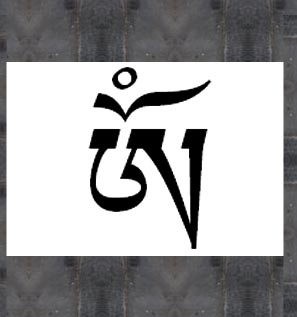
The meaning of the chant is equally beautiful. Om or Aum is a sacred or mystical syllable of the Hindu religion but is also of great importance in Buddhism as well. It is a droning intonation used in the beginning or at the end of every sacred text used in a prayer in a Hindu worship. It has a profound meaning signifying the ‘universal existence’. The symbol is also synonymous with the Absolute or the Almighty.
Mani in Sanskrit means jewel or gem and Padma means a lotus. Hence the chanting translates itself into the universal existence lying in the jewel of the lotus (probably at Buddha’s feet).
Prayer wheels are another fascinating aspects of Buddhism. They are cylindrical wheels perched on spindles. Traditional prayer wheels have ‘Om Mani Padme Hum’ inscribed on the outside of the wheel. The Mantra is also written in paper scrolls and are put inside the prayer wheel. It is such a pleasure watching a Buddhist practitioner gently spin the prayer wheels while simultaneously humming the Mantras. Usually (specifically in Tibetan Buddhism), these prayer wheels are spun in a clock-wise direction so that the motion of the inscribed Mantra reflects the movement of the sun across the sky. Spinning a wheel is said to have the same meritorious effect as orally reciting prayers.
The concept of spinning of the prayer wheel is a physical manifestation of Lord Buddha’s philosophy of ‘turning the wheel of Dharma’, Dharma being the natural law that is of prime importance in Hindu religion.
Our Buddhist journey begins with spinning the prayer wheels while chanting ‘Om Mani Padme Hum’ like expert Buddhist practitioners (or as I would like to believe!)…










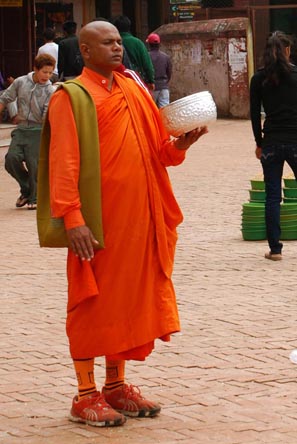


Boudhanath Stupa
The Nepali Buddha is depicted by a pair of beautiful and mersmerising eyes – the ‘all-seeing’ eyes. The Buddha has a pair of eyes only, with a question mark in the place of his nose. This symbol is actually the number ‘One’ in Nepali script, a symbol of unity. The Buddha seems to observe in all the four directions and each pair of eyes represent Wisdom and Compassion. Above each pair of eyes is another eye, the third eye. When Buddha preaches, cosmic rays seem to emanate from this third eye. The Stupa consists of a huge Mandala, a hemisphere which depicts the universe and absolutely dominates the skyline amidst thousands of 5-coloured flags fluttering in the wind. The yellow markings on this Mandala depicts lotus petals. The architecture is an assimilation of symbolic depictions of all the 4 elements – air, water, earth and fire. 108 images of Buddha line the base of the hemisphere. Prayer wheels dot it’s base at the ground level and Buddhist practitioners walk past these prayer wheels in a clockwise direction while spinning them, the process of which is known as circumambulation.
The ancient site is one of the holiest Buddhist sites in Kathmandu Valley and is also one of the largest in the world. This is also the centre of Tibetan Buddhism in Nepal as is evident by the number of Gompas/Monasteries that have come up surrounding the Stupa. During Losar, the Tibetan New Year, the entire site is lit up with butter lamps and is marked with a month-long celebration.
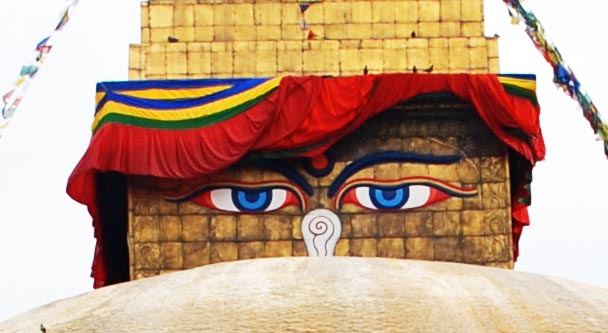

The 5 directions (the Centre, East, West, North and South) are encompassed by a Dhyani Buddha and is depicted by a colour, a carrier, a Mudra or a gesture for Buddha’s fingers, a cosmic element etc. Our guide, Mr Narayan Shreshta enamored us with little stories underlying the various philosophies in such an enticing manner that literally urged us to look beyond the beauty of the surrounding landscape.
An easy and beautiful rendition of the various symbolism of these 5 Dhyani Buddhas can be found here. The 5 Mudras or the gestures of the Buddha are as follows (Image Courtesy: Web):
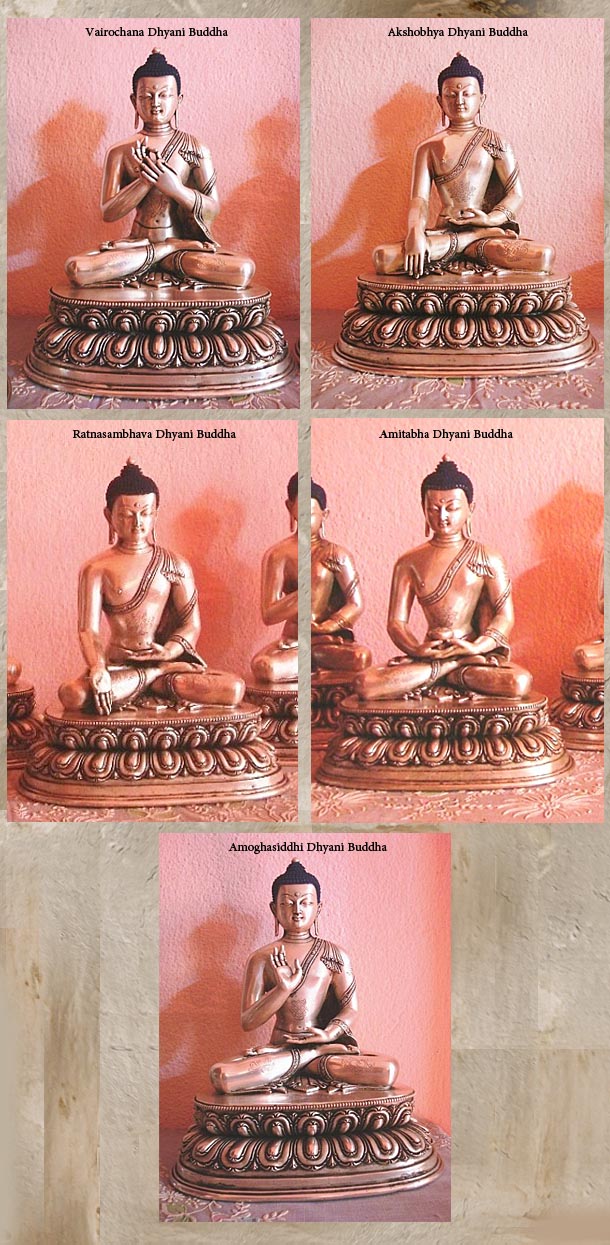
Vairochana Dhyani Buddha; Direction – Centre
Colour – White; Carrier – Dragon
Mudra – Dharmachakra i.e. turning the Dharma-wheel (teaching)
Akshobhya Dhyani Buddha; Direction – East
Colour – Blue; Carrier – Elephant
Mudra – Bhumisparsa (Earth-touching)
Ratnasambhava Dhyani Buddha; Direction – South
Colour – Yellow; Carrier – Horse or Lion
Mudra – Varada (Bestowing, giving)
Amitabha Dhyani Buddha; Direction – West
Colour – Red; Carrier – Peacock
Mudra – Dhyana (Meditation)
Amoghasiddhi Dhyani Buddha; Direction – North
Colour – Green; Carrier – Garuda
Mudra – Abhaya (fearlessness)
Tibetan Curio shops selling various Bhuddhist artifacts and traditional Tankha paintings, Kashmiri garment shops selling intricately embroidered Pashminas and woollens, Buddhist practitioners spinning the prayer wheels while chanting Mantras, young Buddhist monks wearing red robes and discussing mobile phones as well as philosophy of attaining enlightenment in the same breath and the bewildered tourists amidst the noisy fluttering of thousands of 5-coloured flags – all these add a quaint charm to Boudhanath. As Mr Narayan tells us more on religion, myths and legends, Buddha seems to come alive – the magnetic pair of eyes from above the Stupa observing us as we go into our own spiritual journeys.


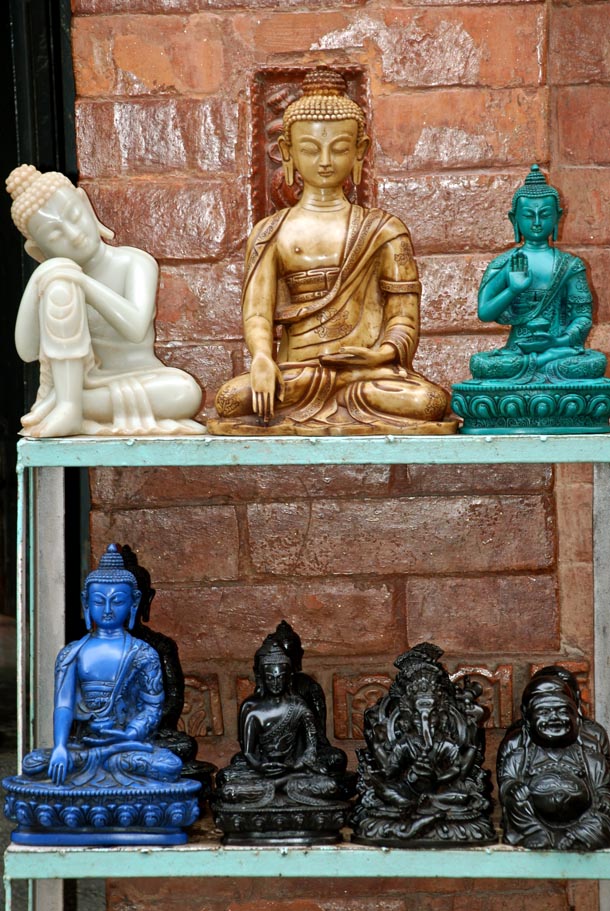

Faith seems to bind everyone here – from Buddhist devotees to others who follow different religions or perhaps even the atheist. Lighting up candles with prayers in the hearts, the spinning of the prayer wheels and the assimilation of all these faith seems to harp on only one thing – we are all but ONE belonging to the same universe! This unique assimilation is also reflected by the artifacts dotting the curio shops, for example – the interesting metal artifact above – a serpent-headed angel cum mermaid or perhaps the symbol OM written in various scripts.
Swayambhunath Stupa
The ancient religious Stupa of Swayambhunath is perched on a hill in the west of Kathmandu and is a UNESCO World Heritage Site. The view from the top overlooking Kathmandu city is beautiful. Like Boudhanath, here too the ‘all-seeing’ Buddha eyes seem to observe in all directions and seems to hover around and protect the entire Kathmandu Valley. During Buddha Jayanti or celebrations commemorating the birth of Buddha, Buddhist monks and nuns along with other devotees climb up the steep hill to circumambulate (walk around) the Stupa.
There are approximately 350 steps to climb up this steep hill and yes, we did climb up along with the Z-SISTERS though Li’l Z was insisting that I shoul carry her all the way up. As if Mummy was a supergirl! We climbed up breathless and sweating, realising how unfit we had become, thanks to the kind courtesy of escalators and elevators in our modern lifestyles. It dawned upon us that before we even dream of our next holiday we have to first enroll ourselves into intensive cardio and fitness programmes!

Legend has it that the entire valley was once filled with an enormous lake, out of which grew a lotus. The Bodhisatva Manjushri (‘Bodhisattva’ refers to the enlightened one and ‘Manjushri’ is a Bodhisattva associated with transcendent wisdom) had a vision of the lotus at Swayambhu and travelled all the way here to worship it. To make the site more accessible to pilgrims and for development of human settlement, Manjushri cut a gorge. The water drained out of the lake, leaving the valley in which Kathmandu now lies. The lotus then transformed into a hill and the flower become the Swayambhunath Stupa. The valley came to be known as Swayambhu, meaning ‘Self-Created’.
Swayambhunath is also known as the Monkey Temple as there are holy monkeys living in parts of the temple in the north-west. They are holy because Manjushree, the Bodhisattva of wisdom and learning was raising the hill on which the Swayambhunath Temple stands on. He was supposed to leave his hair short but he kept it growing long and long which eventually became infested with lice. The lice later transformed themselves into monkeys!
There is another Hindu Legend according to which Lord Krishna drained out the water from the lake with one swipe of his sword. Whatever be the story of it’s origin, evidence by scientists suggest that the valley was indeed under water and there is a gorge at a place called Chovar!
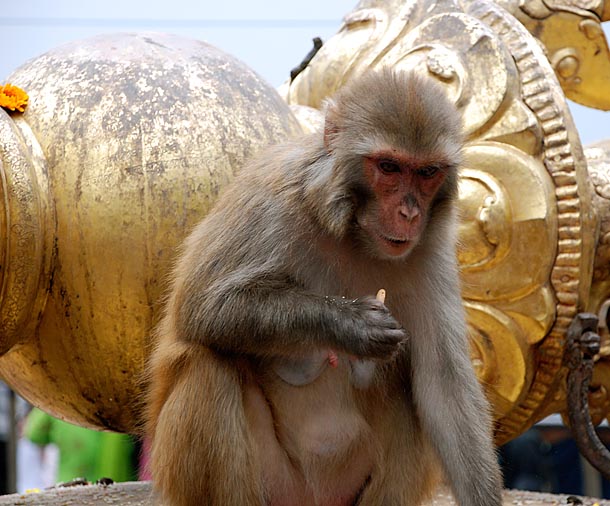
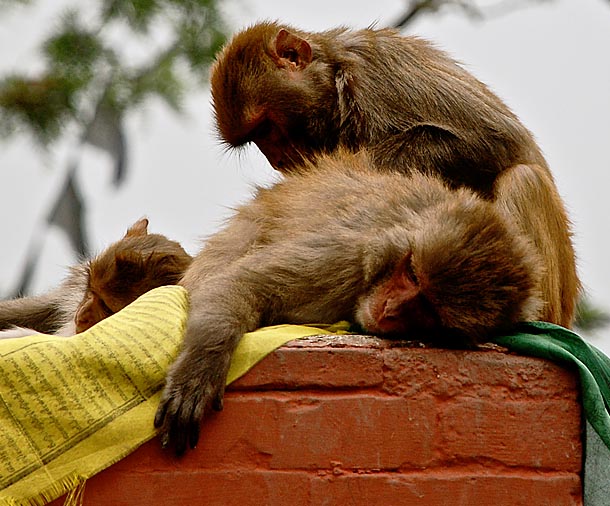
Stupa, shrines and temples adorn Swayambhunath. The site is revered by both Buddhists and Hindus. You could describe this as the very charm of religion in Nepal or you may find this entire concept of co-existence of different religious philosophies bewildering.


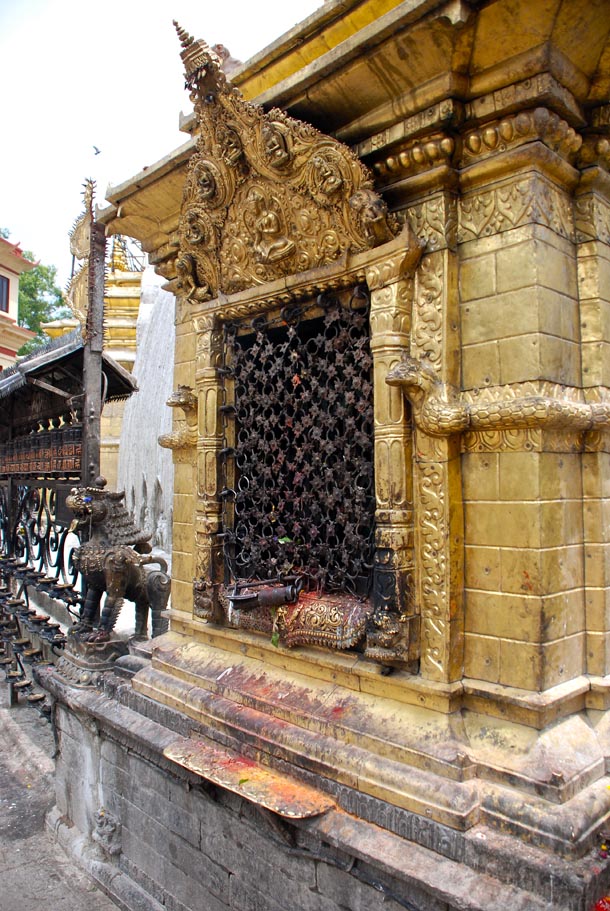


After climbing up the steep hill and finding ourselves absolutely breathless, the first thing that compensates all the calories burnt (hopefully!) is the breathtaking view of Kathmandu Valley from the hill-top. But please note that climbing the hill may seem to be an easier task than to get a little peep into the valley through the jostling and stubborn crowd!


Apart from the religious and the spiritual aspect, the hill-top has an amazing array of jewellery and artifacts pertaining to both Buddhism, Hinduism and other non – spiritual elements that is sure to make you go bankrupt. Even with the knowledge that probably the same things could be available down in other touristic spots like Thamel at a much cheaper price defies all emotional logic. Each piece is a work of art, either painstakingly hand-made or intricately carved. What if you don’t come across these elsewhere?
Our visually and emotionally stimulating journey…





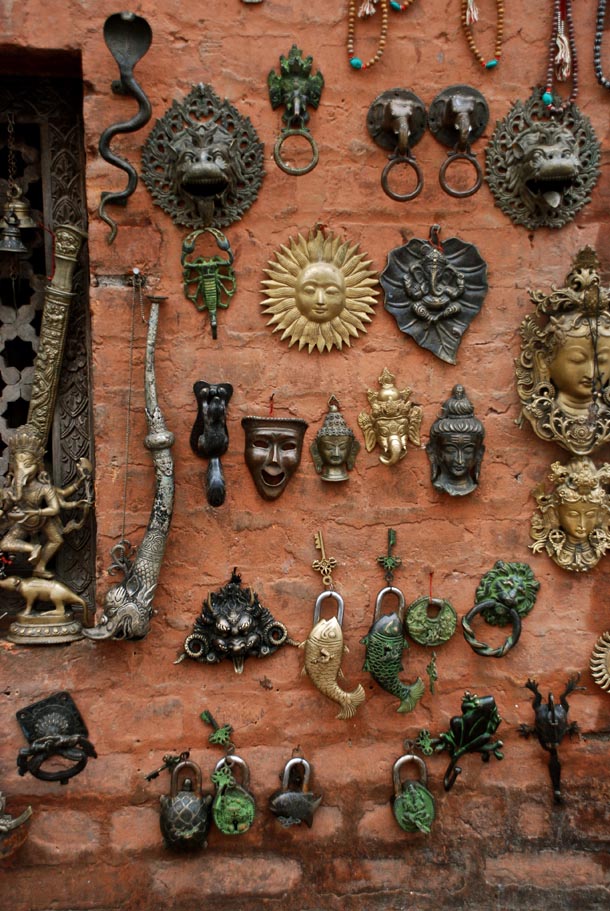
And finally, I chanced upon one of my favourite item that I keep on collecting from everywhere – singing bowls. Singing bowls are used as a signal to begin and end periods of silent meditation and plays a very significant role in Buddhist prayers along with the praying wheels.
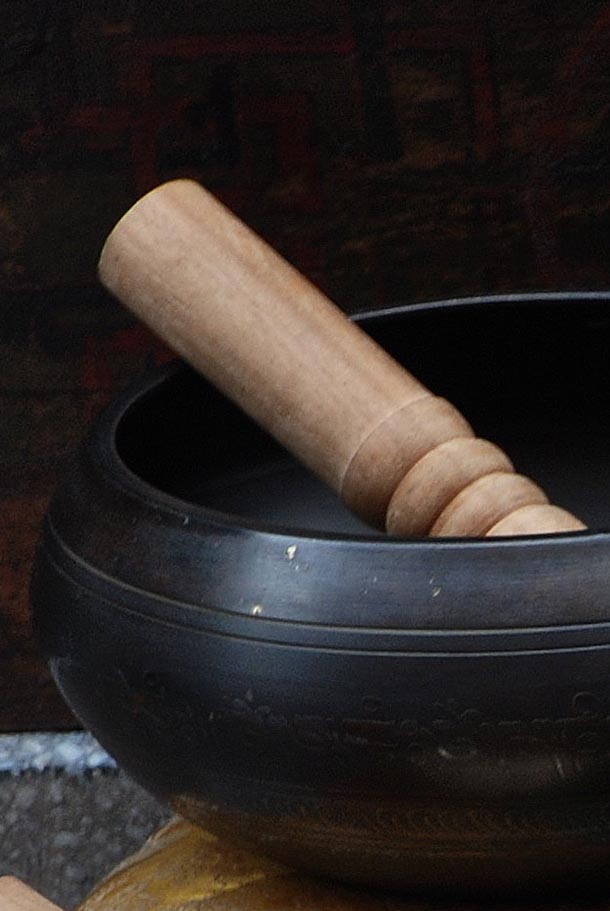
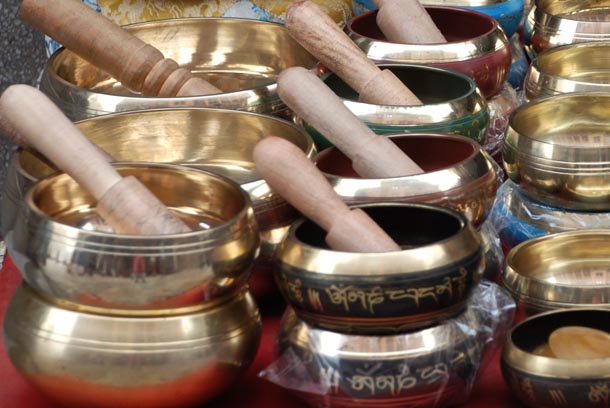
Every time we return back to our hotel I have a huge task at hand – deleting pictures. Not to accommodate new pictures of the next day but to delete the innumerable duplicate ones that I must have clicked resulting from hyper-activity and over-excitement. I can’t even remember those days when digital camera were not there and we had to buy film rolls. We would wait for ‘those’ 24 or 36 perfect moments to take a few historical pictures. Do you remember those pre-historical times? Was that better than having digital cameras where tourists like me end up taking at-least 200 pictures on a half-day trip like the one that I am still writing on? It’s been a long time that I have even seen these words – Kodak films or Fuji Films and am so glad to know that they are still available in some places in the world. That means that some people still exist who are happy with simple pleasures in life – like clicking as little as 36 images during an entire vacation!
Unblogging it all… Ishita
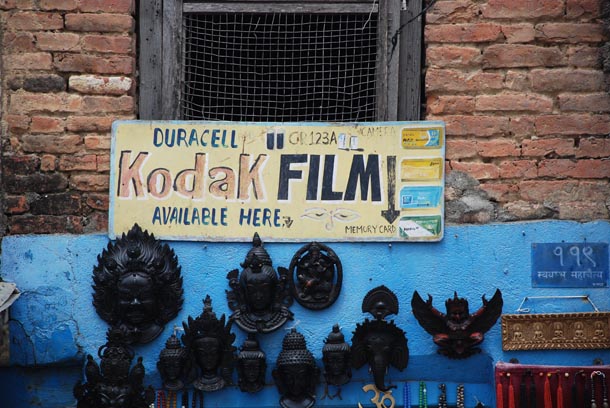

Other articles on our Nepal trip
Daal Maharani Befitting the Queen (And Also Us) – Recipe
Sikarni Raan/Marinated Lamb Shank from Yak & Yeti – Recipe
Flying over Mt Everest – Nepal
The Abandoned Women Amidst Many Prayers
Related articles over the web
Swayambhunath, Bouddhanath, UNESCO World Heritage Site, Stupa, Om Mani Padme Hum,Mantra,Om,More on OM,Prayer Wheels, More on Nepal, Introduction to Nepal


I still havn’t read the script. But the pics took me through a colourful spiritual journey. Fabulous.
LikeLike
Thank you… Looking forward to your comments after you read through the post at leisure:)
LikeLike
first but not the last . THANKS !! for nepal ki sair . wo bhe nairobi beethay beethay :))))
loved the fact that in nepal many religions are intermingled , personally i think ,this shows tolerenance in nepali people , and tolerence for other religions and letting em intermingled withhin each other is a huge thing for me , in this age of less or no tolerance sp for other religions.
i am a huge fan of budhissam only for one fact that,, budhissam preaches self control and forgivness :))))) .everything written and posted was very insightfull .i ve a hand painted poster of budha on batik all the way from india but thanks to you , now i know i have the AMOGHASIDDHI DHYANI Bhuddha…. :)))))
i ve found the legend very intrsting too specially how you showed the link between the legends and scintific studies ,,,,
KUDOS !!!! enjoyed it completely ;GOD BLESS
LikeLike
Poonum – I so love your feedbacks – I always have since you have been encouraging and appreciating me since my blog was just an one-post old! Infact I’ve also not given so much of thought to all the Mudras of Buddha till we went to Nepal. There Buddhism pervades through the air and the surrounding landscape. And the Buddha eyes are so mersmerising. Comments like yours make my day – they help me to evolve even more. Love your thoughts as well and the liberal outlook that you have!
LikeLike
Gorgeous pictures AND lovely narrative. As usual my friend. 🙂
LikeLike
Thank you. You are always very kind with your remarks – sincerely look forward to your comments!
LikeLike
Thank you so much for sharing your fantastic photos. I feel like I’ve been on a bit of a journey!
LikeLike
Thank you so very much – mission accomplished then:)))
LikeLike
Wonderfully captured journey! I enjoyed reading your post 🙂 And yes, I cannot imagine analog photography anymore…
LikeLike
Thanks. Wow! Then I’m not the only one in this digital vs analog maze!
LikeLike
Definitely not! 🙂
LikeLike
awesome photos Ishita..enjoyed each of them 🙂 I followed u at twitter.(sweta_blr)
LikeLike
After a long time Sweta:)
LikeLike
Been busy like hell..
LikeLike
It’s busy in Hell is it? I thought you had only one thing to do in Hell – burn in fire! Just kidding. Welcome back!
LikeLike
Ya ..the age old concept of hell which got etched in our minds reading those stories in childhood..haha..anyway thanks..but again going to be busy for a while.
LikeLike
Do drop in when you have some spare time – for some earthly refreshment:)
LikeLike
Wow what beautiful memories…i love nepal!!!! still to write up from my nepal trip early this year on my personal blog. but reading this- you seemed to have covered everything (and probably better than i could do 😉
thank you for reminding me that there is such a lovely place in the world x
LikeLike
Please write your take on Nepal – we all have our different perspectives and it’s wonderful to read all of them. Nepal was really a different experience – yet to write about some other beautiful experiences. Look forward to your write-ups – I can be really insistent!
LikeLike
haha I will, but maybe on my personal blog… nepal is one of the little things that can keep me entranced even if food is not involved, not very common for me!
LikeLike
I can well imagine!
LikeLike
Pingback: Gift Wrapped & Preserved For Each Tourist – Chitwan «
I’m off to Kathmandu this Thursday for a long weekend. Now very excited 🙂
LikeLike
Wow Sally! Have a great holiday. Please try to book a mountain flight over the Himalayas – if the weather is good that is surely going to be one divine experience. Enjoy-y-y…..
LikeLike
Pingback: Innocense In Their Eyes, Joy In Their Faces «
Pingback: Innocence In Their Eyes, Joy In Their Faces «
Pingback: Bori Tarkari/ Beans Curry & Maithili Art – Chitwan «
Pingback: UNESCO World Heritage Sites That I’ve Visited | Tracking My Foot Prints |